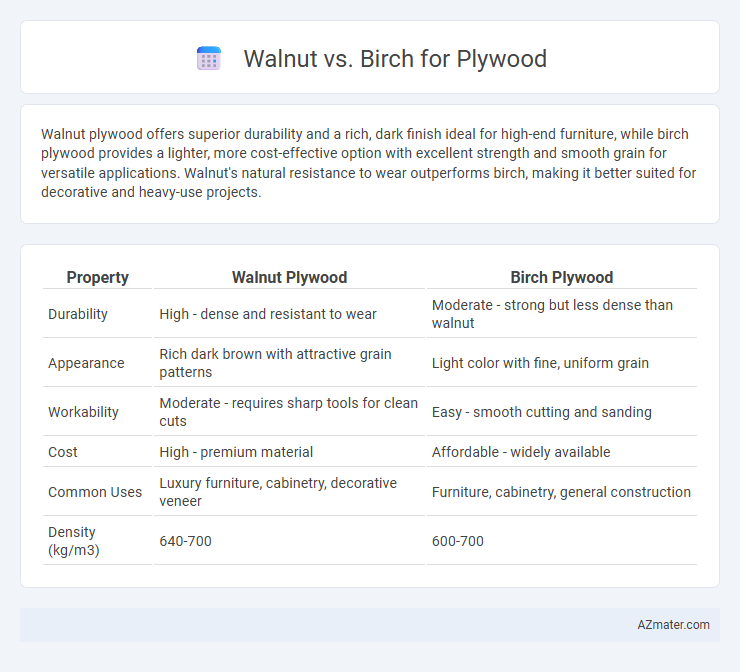Walnut plywood offers superior durability and a rich, dark finish ideal for high-end furniture, while birch plywood provides a lighter, more cost-effective option with excellent strength and smooth grain for versatile applications. Walnut's natural resistance to wear outperforms birch, making it better suited for decorative and heavy-use projects.
Table of Comparison
| Property | Walnut Plywood | Birch Plywood |
|---|---|---|
| Durability | High - dense and resistant to wear | Moderate - strong but less dense than walnut |
| Appearance | Rich dark brown with attractive grain patterns | Light color with fine, uniform grain |
| Workability | Moderate - requires sharp tools for clean cuts | Easy - smooth cutting and sanding |
| Cost | High - premium material | Affordable - widely available |
| Common Uses | Luxury furniture, cabinetry, decorative veneer | Furniture, cabinetry, general construction |
| Density (kg/m3) | 640-700 | 600-700 |
Introduction: Walnut vs Birch Plywood
Walnut plywood offers a rich, dark grain pattern and exceptional durability, making it ideal for high-end furniture and cabinetry. Birch plywood features a light, uniform texture with superior strength and smoothness, commonly used in construction and interior applications. Comparing Walnut vs Birch plywood highlights differences in aesthetic appeal, hardness, and cost, influencing material choice for specific woodworking projects.
Overview of Walnut and Birch Wood
Walnut plywood is prized for its rich, dark brown color and fine, straight grain, providing a luxurious and elegant finish in woodworking projects. Birch plywood features a lighter, creamy color with a smooth, even texture and higher strength-to-weight ratio, making it ideal for structural applications and furniture. Both woods offer excellent stability and workability, but walnut's aesthetic appeal contrasts with birch's durability and economical value in plywood production.
Appearance and Grain Pattern Comparison
Walnut plywood features a rich, dark brown hue with deep chocolate tones and a smooth, straight grain that often exhibits subtle, wavy patterns, providing an elegant and luxurious appearance. Birch plywood showcases a lighter, creamy to pale yellow color with a fine, uniform texture and a predominantly straight, even grain, creating a clean, modern aesthetic well-suited for minimalist designs. The contrast between walnut's darker, more dramatic grain and birch's lighter, consistent pattern influences furniture and cabinetry choices depending on the desired visual impact.
Strength and Durability Differences
Walnut plywood offers moderate strength with a fine, dense grain that provides good resistance to wear and impacts, making it suitable for decorative applications. Birch plywood is known for its superior strength and excellent durability, featuring a tight grain structure that resists warping and splitting under heavy loads. For projects requiring maximum structural integrity and long-lasting performance, birch plywood is generally preferred over walnut due to its robust mechanical properties.
Cost and Availability Analysis
Walnut plywood tends to be significantly more expensive than birch due to its scarcity and high demand in luxury woodworking and furniture projects. Birch plywood is widely available and offers a cost-effective solution with consistent quality, making it a preferred choice for large-scale construction and cabinetry. The broader supply chain and faster growth rate of birch trees ensure steady availability compared to the more limited walnut resources.
Workability and Finishing Qualities
Walnut plywood offers superior workability due to its fine, uniform grain and moderate hardness, allowing for easier cutting, sanding, and machining while maintaining dimensional stability. Birch plywood is also highly workable, featuring a smooth texture and consistent grain that accepts nails and screws well, though it is slightly harder and may require more effort in detailed carving or shaping. In terms of finishing, walnut provides a rich, deep color with excellent stain absorption and a smooth, polished surface, while birch finishes to a light, even tone that highlights its subtle grain pattern, making both ideal for high-quality furniture and cabinetry.
Environmental Impact and Sustainability
Walnut plywood is less commonly produced, resulting in limited availability and a higher environmental impact due to slower growth rates and increased resource consumption. Birch plywood, sourced from fast-growing, sustainably managed forests, offers a more eco-friendly option with lower carbon emissions during harvesting and processing. The renewable nature of birch combined with efficient manufacturing practices positions it as a preferable choice for environmentally conscious woodworking projects.
Common Uses in Furniture and Cabinetry
Walnut plywood is prized in furniture and cabinetry for its rich, dark color and smooth grain, making it ideal for high-end, visually striking pieces like custom cabinets and luxury furniture. Birch plywood offers superior strength and a light, uniform finish, commonly used in structural cabinet components and modern, minimalist furniture designs. Both materials provide durability, but walnut is favored for aesthetic appeal, while birch excels in cost-effectiveness and versatility.
Pros and Cons of Walnut vs Birch Plywood
Walnut plywood offers a rich, dark aesthetic with natural durability and resistance to wear, making it ideal for high-end furniture and cabinetry but comes at a higher cost and limited availability. Birch plywood provides a lighter, consistent grain pattern with excellent strength and stability, favored for structural applications and budget-friendly projects despite being less visually striking. Walnut's premium appearance suits decorative uses, whereas birch's versatility and affordability make it practical for both structural and finished surfaces.
Conclusion: Choosing the Right Plywood for Your Project
Walnut plywood offers rich, dark tones and superior durability, making it ideal for high-end furniture and decorative finishes that require a premium appearance. Birch plywood provides a lighter, more uniform surface with excellent strength and affordability, suited for structural applications and versatile design needs. Selecting between walnut and birch plywood depends on balancing aesthetic preferences, budget constraints, and the specific functional requirements of your project.

Infographic: Walnut vs Birch for Plywood
 azmater.com
azmater.com